Finding a public space to sit down and write this article was a struggle. My neighbourhood library is under renovation and will be for the next 12-18 months, and it was still too chilly and rainy this past month to set up in a park nearby. When the weather eliminates outdoor options in Toronto, it’s hard to find a ‘third place,’ where I can settle in for an extended time outside of home or office.
I have issues with Starbucks, the flavour of their coffee, their exorbitant prices, their union-busting tactics; but they were an industry leader that understood the impact that providing a comfortable café environment had on the experience of spending time within their stores.
Starbucks has – since its inception – benefited from a business model based on the cultivation of a community-centric experience that attracts customers not just for the coffee, but for the people and the space itself. Customers enjoyed the conversational atmosphere, people joked about the baristas who almost know their name, and the warm Wi-Fi-enabled seating area invited you to lounge for hours.
This experiential element of Starbucks’ success isn’t a secret; the public mission statement of Starbucks Canada is a motto so syrupy it’s fit for their menu: “With every cup, with every conversation, with every community – we nurture the limitless possibilities of human connection.”
Starbucks has for decades attempted to cultivate ‘Third Places,’ or casual social settings found outside of the home and work. They’ve frequently used the term in their marketing and even brag that their innovative café predates the term, which was first coined in 1989.
In the case of my own neighbourhood store, it was able to provide this setting for over two decades. But the location’s gradual transition, from a spacious two-room coffee lounge with ample seating to a one-room mobile pickup lane, undermines that function.
The location in question has just been renovated into a new layout that could best be described as ‘express,’ a style that will soon be replacing many other locations across the chain.
Perhaps the best way we can recognize when a third place is under threat is if we dig a little further into their history.
A brief history of the Third Place
The year is 1633; fearing the propagation of radical ideas, Sultan Murad the IV of the Ottoman Empire issued a new law whose violation was punishable by beatings for perpetrators’ first offence and being sewn into a leather bag and thrown into the sea for their second. In 1672 King Charles II of England embedded a network of spies throughout the country to, as he proclaimed, “Restrain the Spreading of False News, and Licentious Talking of Matters of State and Government.” The crime targeted by both leaders? The operation of coffee houses.
Coffee houses are one of the earliest examples of ‘Third Places,’ a term popularized by urban sociologist Raymond Oldenberg, who described them as “public places on neutral ground where people can gather and interact. In contrast to first places (home) and second places (work), Third Places allow people to put aside their concerns and simply enjoy the company and conversation around them.” More than that, Third Places are essential to community-building because they bring people together within a shared space who may otherwise remain in more disparate social circles.
It was not the energizing effects of coffee drinking itself that these laws were targeting, but instead the atmosphere its consumption brewed, and the stimulating yet sober conversations that were commonplace at many coffee houses. These ‘penny universities’ became a space where for one penny per cup, the high classes and the low, political rivals of every faction, town gossips, academics, and revolutionary thinkers could all intermingle and build upon the insights of those they would have little reason to interact with otherwise. It was the informality of these settings and the irreverent discussion of society challenging ideas that was deemed by those in power to be the real threat.
Third places are valuable because they cultivate social communities who are more aware of their neighbours, who discuss local news, and where attendees can talk about issues and perspectives that they may not find at home, or would be taboo in the professional setting of work.
Enter Starbucks
First launched in Seattle in 1971 as a coffee bean roastery, it wasn’t until the onboarding of Howard Schultz in 1984 that they even served their first brewed cup. The massive expansion of the chain over the following decades has been undeniable, but in the 1990s the layout of the store was first standardized to include warm colours, coffee tones, and comfortable seating arrangements. Schultz was very aware of their community capture goals when he described the design ethos as “intended from day one to build a Third Place between home and work … at a time in America when people are hungry for human connection.” As of 2023 there are more than 38,000 Starbucks locations worldwide, many of which follow Schultz’s design ethos.
My local Starbucks can be understood as having gone through three distinct design phases.
Initially the location was a two-room space, with one side serving as a seating area complete with tables, leather chairs, and even a fireplace. The location was frequented by neighbourhood families, and I vividly remember waiting there for after-school activities with various crowds who each needed large community spaces to meet up.
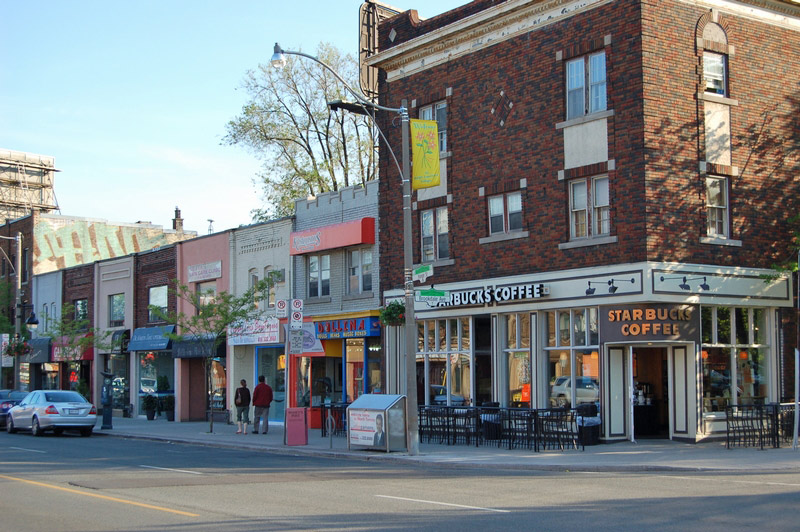
Around 2012, in phase two, the lounge half of the store was sold off and the remaining room renovated to a layout many Starbucks locations still use today. A coffee counter then took up half the remaining space. Limited benches and smaller tables replaced the leather lounge chairs, and a new counter was installed along the window, lined by highchairs. This stage of the store was undeniably tighter but still welcoming, though noticeably more individualistic with a seating plan that prevented most customers from facing each other.
Another round of renovations have recently been finished and the space has yet again had its layout changed. According to official messaging from Starbucks, this new style of franchise was meant to improve accessibility for customers, providing more space for movement and lower counters for service. While accessibility is undeniably an important goal, it does seem that Starbucks is using the virtue of accessibility to obscure their real goal of reducing the amount of customer seating. The lower counters may indeed assist customers with mobility constraints, but the addition of a massive flat screen for listing mobile order numbers doesn’t seem to make the space noticeably more accessible.
The warm creamy colours, rounded minimalist edges, and scant furniture feels straight out of Marie Kondo’s design book, but this clean modernism strips the location of any distinct personality. Where there were around 20 seats just last month, there are now maybe 4-6 seats total in the exact same space. All of these seats are individual and face a blank wall with a ledge just deep enough to place one’s coffee, but not quite comfortably support a laptop.
Most egregiously, all of the window seating is gone, and in its space stand faux chic leather leaning bars that most closely resemble what a horse would be tied to outside a saloon. I guess customers are expected to awkwardly rest against the bar while waiting for their coffee to be prepared, after which point, they are expected to promptly leave.
It’s unsurprising that the location would optimize its layout for a new digital ‘frictionless’ consumer era, one in which social communities have all but shifted online to platforms, and where companies focus increasingly on the commodity, rather than the setting, community, and atmosphere that the commodity is consumed within. The reason this redesign is concerning to me is not just that the company has decided to literally cut corners off their counter and their overhead, but just how antithetical adding hostile architecture to the space should be to Starbucks’ own purported ethos.
From their design choices to their public messaging, I’m concerned that Starbucks may not actually know what a Third Place is. After all they were the ones that claimed “the Third Place has never been defined solely by a physical space, it’s also the feeling of warmth, connection, a sense of belonging Starbucks [sic].”
Starbucks has decided to side-step this contradiction by claiming that what they are doing is actually helping to ‘evolve’ the Third Place. In their article they promise they’re “keeping coffee and connection at the centre” which they will achieve by “making work easier for partners [staff], enabling stronger engagement and connection between our partners and the customers they serve, and delivering experiential convenience.” ‘Connection’ sounds great, but the word is strategically used so that each time they say it it’s only describing the connection between their staff and the customer. Not once do they suggest these changes will support ‘connection’ like community bonds forming between the customers themselves. What this promise really says is that Starbucks’ plan is to deskill their baristas, increase service satisfaction, and make ordering convenient through focusing on mobile pick-ups.
Even the corporate art is just boring cell-shaded images of coffee pots and mugs. One piece that encapsulates the heart of Starbucks’ current contradiction is placed above one of the uncomfortable leaning bars. It’s an illustration of a community of locals congregating around a Starbucks location, the first ever location opened in Seattle to be precise. They’re young, diverse, artistic, queer-coded, and sharing the public space in front of a community-integrated coffee shop that even the busking musician has decided to get their coffee from. It’s a pleasant image, but it reflects the corporate mythos that Starbucks so desperately wants its clientele to still see in them.
The Starbucks this piece occupies is no longer a community hub – its capacity to function as one has been filtered out by profit-seeking decisions such that all that’s left is aesthetic and iconography.
Starbucks has reached a crossroads in deciding what it is: a contributing cornerstone of the community, or an express take-away spot. Compared to their indulgent motto, my local Starbucks no longer cultivates conversation, community, and human connection, and yet these remain the ideals the corporation prides itself on. The chain is facing a crisis of identity as it tries to balance its preferred image as a quaint, local, Seattle-based, community-oriented coffee shop, with the alienating reality of each store becoming one optimized location of a $102-billion multi-national coffee empire.
The death of the Third Place
There is a risk inherent to entrusting the cultivation of a Third Place to a business that only wants to sell that experience back to customers. A for-profit company is not going to altruistically provide a community space just because they love your neighbourhood that much, unless you’re willing to pay for it. The issue then for Starbucks is that customers thought that they already were paying for it.
People go to Starbucks and are willing to pay a premium price for the premium experience, but by removing that experience from the equation Starbucks is now competing exclusively on product, and the bad news for Starbucks is that their product is not premium.
A Third Place doesn’t necessarily have to be free, and in fact most Third Places are not free – a couple dollars or so for a coffee or a snack gives you the permission to take up space in the store for an extended period. It used to be that if you went with a friend to a Starbucks but only one of you got a coffee, the other friend was still welcomed to spend time in the store.
Third Places must ultimately be community cultivated and not just community occupied. When a space is being provided by a multi-national corporation like Starbucks, they have no obligation to customers to preserve that space. Especially if a smaller store with faster turnover would ultimately be more profitable for them.
For readers looking to find Third Places the good news is that for now they do still exist throughout the city. However, without regular patrons that could always change. Seek out the cafes, reading rooms, and esoteric bookstores of Kensington Market. For world renowned collections of books and high speed free public Wi-Fi, one hundred Toronto Public Libraries are scattered throughout the city. For close quarters laughs many small bars host casual open-mic nights for everything from comedy to music to poetry.
Though convenient and recognizable, Starbucks is not your friend. If you want to cultivate a lasting Third Place in your community it has to be locally owned, socially oriented, and staffed by members of the community who you know, and who know you. Whatever your scene is, Third Places exist because they attract returning local regulars, so my best advice is to find somewhere local that you want to return to regularly. Soon enough you too will be a part of what makes that Third Place special.
Right now, our Third Places are under siege and are rapidly being lost. I encourage you to consider if your favourite Third Place, as long-standing as it may be, is in a similarly precarious spot.
Sincerely (at least according to my Grande Caramel Macchiato),
Frank

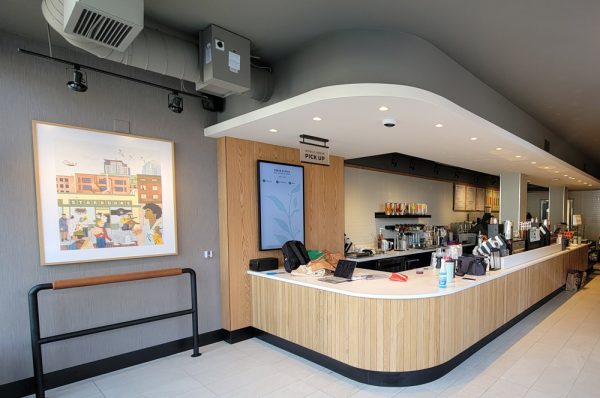
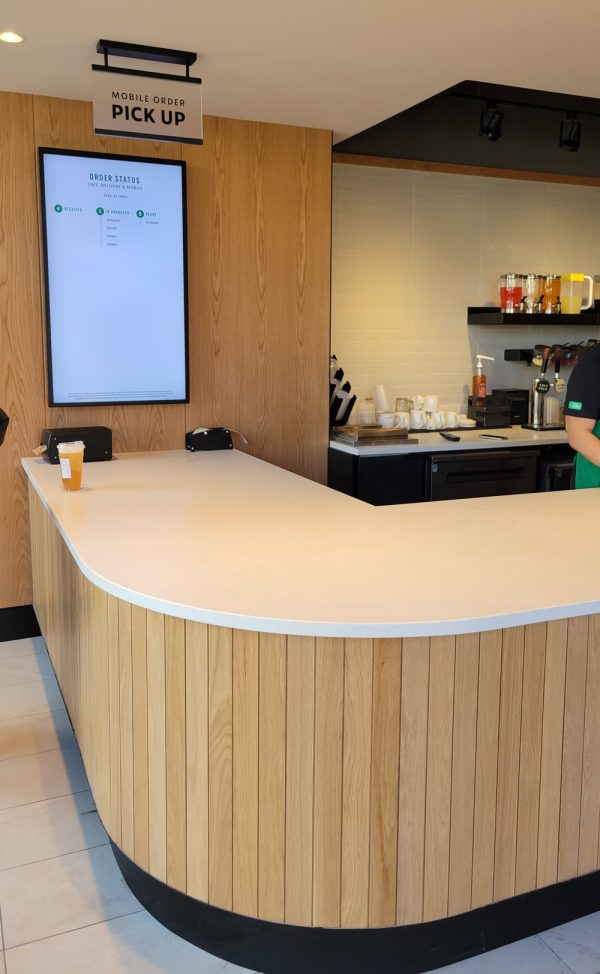
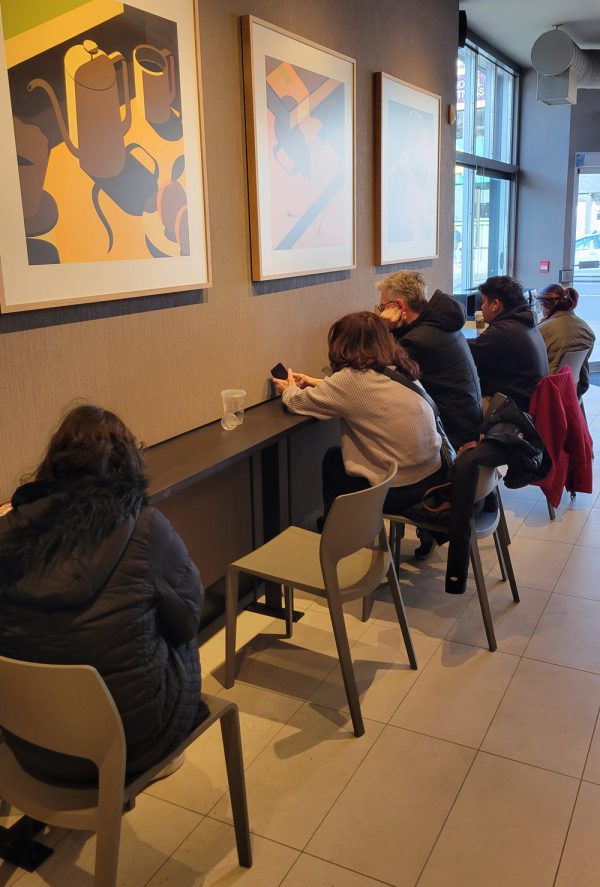
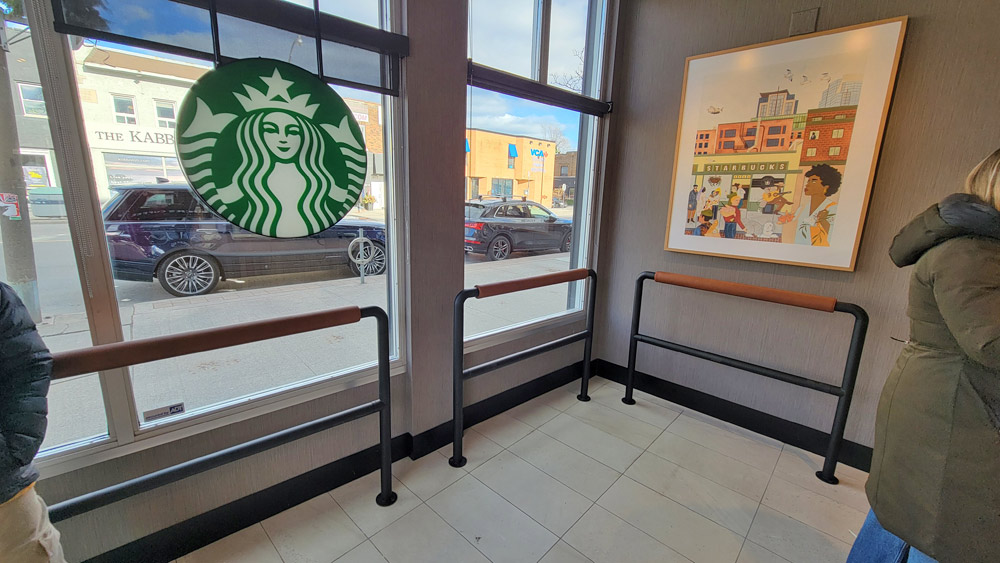
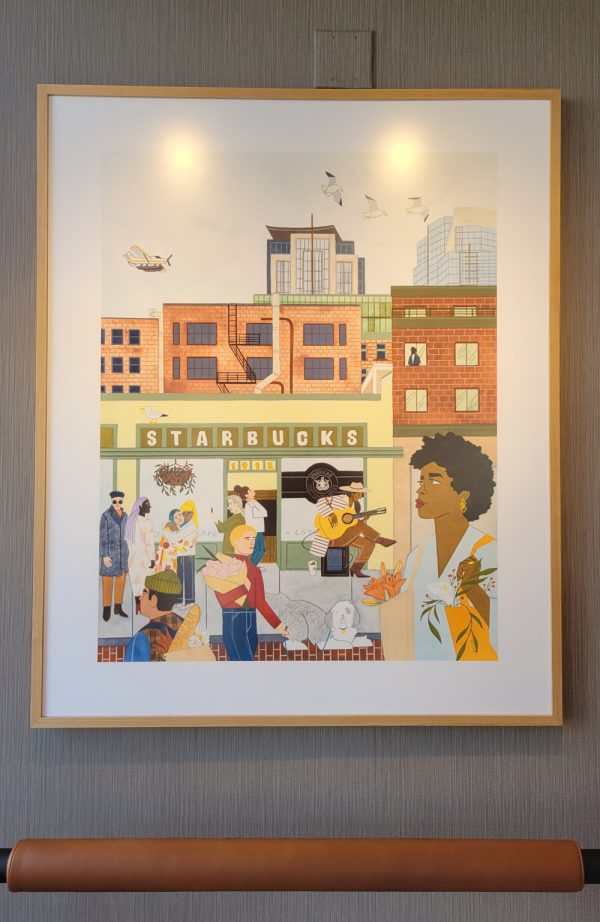


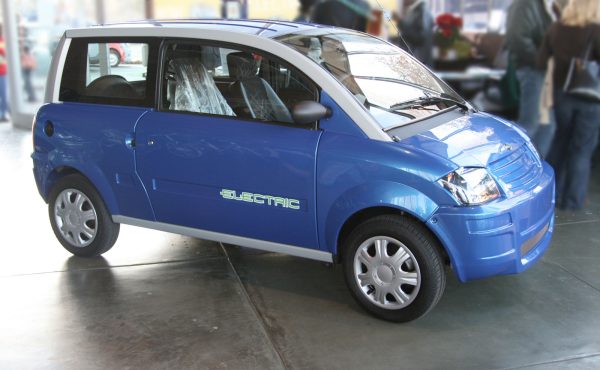
4 comments
I’ve never understood the business model of buying a coffee and subsequently spending hours occupying a space in a business, think how many other patrons that also bought coffees might have liked to sit in the chair you’re occupying but weren’t able to.
I see here another consequence of a Pandemic that hasn’t yet ended, despite the socio-political pressure to pretend otherwise.
It seems like they have a lot of indoor seating despite having a small cafe footprint. I don’t see what the complaint is though, is the writer arguing that the furniture isn’t as comfortable as a couple plus chairs? The truth is stores need to expand their BOH and frontline area in order to service their customers and that comes at the expense of some cafe space. Hence the shared wall table and stools.
Starbucks used to be my plan-B whenever I want to grab a drink and do casual work. Now I have no place to go in my neighborhood